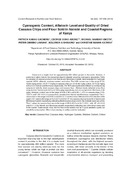| dc.contributor.author | Gacheru, Patrick Kamau | |
| dc.contributor.author | Abong, George Ooko | |
| dc.contributor.author | Okoth, Michael Wandayi | |
| dc.contributor.author | Lamuka, Peter Obimbo | |
| dc.contributor.author | Shibairo, Solomon I. | |
| dc.contributor.author | Katama, Christine Masha | |
| dc.date.accessioned | 2019-04-29T14:29:05Z | |
| dc.date.available | 2019-04-29T14:29:05Z | |
| dc.date.issued | 2015-12-20 | |
| dc.identifier.issn | 197-206 | |
| dc.identifier.uri | http://dx.doi.org/10.12944/CRNFSJ.3.3.03 | |
| dc.identifier.uri | http://erepository.kibu.ac.ke/handle/123456789/772 | |
| dc.description.abstract | Cassava is a staple food for approximately 800 million people in the world. However, it
poses food safety risks to the consumers due to naturally occurring cyanogenic glucosides. Thirty
six samples of cassava products from Nairobi and Mombasa markets were evaluated for hydrogen
cyanide (HCN), aflatoxin, moisture content, and colour. The HCN content was in the range 27.20-
42.92 mg/kg and 21.45-37.77 mg/kg in cassava chips; 21.53-64.63 mg/kg and 21.70-70.03 mg/kg
in flour from Nairobi and Mombasa respectively. The HCN was significantly different (p≤0.05) among
samples in both the dried cassava chips and cassava flour. Aflatoxin levels detected in two flour
samples from Nairobi were 6.60 and 8.89 µg/kg respectively, and one sample from Mombasa; 2.84
µg/kg. Moisture content was in the range of 8.62-9.98% and 8.85-11.57% in cassava chips; 8.50-
12.51% and 7.30-11.0% in cassava flour samples from Nairobi and Mombasa, respectively. The L*
values were in the range of 83.9-92.0 and 69.0-81.7 and the colour difference from the standard white
paper (DE*) were in the range of 14.5-22.7 and 25.6-37.1 in cassava chips samples from Nairobi and
Mombasa markets respectively indicating dried cassava chips sold in the markets were less white.
The L* values for cassava flour was in the range of 95.3-100.0 and 94.7-100.0 with DE* of 4.6-9.6
and 0.9-11.5 for Nairobi and Mombasa markets respectively indicating very white flours were sold
in the market. These results show that the flour in the market may be of good aesthetic quality but
unsafe for consumption. Effect of processing on safety could be evaluated. | en_US |
| dc.language.iso | en | en_US |
| dc.publisher | KALRO | en_US |
| dc.rights | Attribution-NonCommercial-ShareAlike 3.0 United States | * |
| dc.rights.uri | http://creativecommons.org/licenses/by-nc-sa/3.0/us/ | * |
| dc.subject | Cassava flour | en_US |
| dc.subject | Cassava chips | en_US |
| dc.subject | Hydrogen Cyanide | en_US |
| dc.subject | Moisture Content | en_US |
| dc.subject | Colour | en_US |
| dc.title | Cyanogenic content, aflatoxin level and quality of dried cassava chips and flour sold in Nairobi and coastal regions of Kenya | en_US |
| dc.type | Article | en_US |

